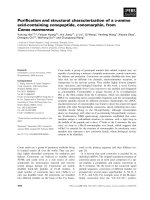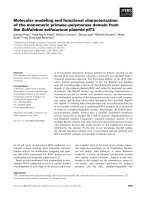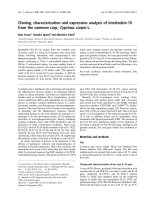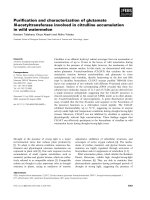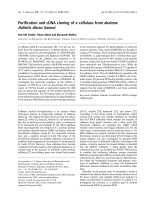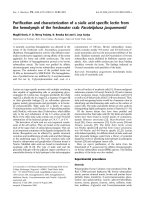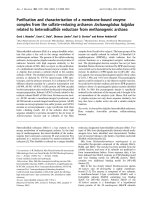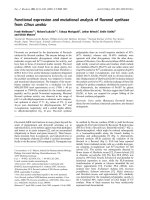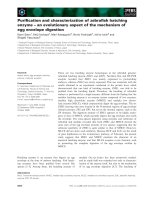Báo cáo khoa học: Purification and structural analysis of the novel glycoprotein allergen Cyn d 24, a pathogenesis-related protein PR-1, from Bermuda grass pollen pot
Bạn đang xem bản rút gọn của tài liệu. Xem và tải ngay bản đầy đủ của tài liệu tại đây (258.33 KB, 10 trang )
Purification and structural analysis of the novel
glycoprotein allergen Cyn d 24, a pathogenesis-related
protein PR-1, from Bermuda grass pollen
Lu-Ping Chow
1,5
, Li-Li Chiu
1
, Kay-Hooi Khoo
2
, Ho-Jen Peng
3
, Sue-Yee Yang
3
, Shih-Wen Huang
4
and Song-Nan Su
3
1 Graduate Institute of Biochemistry and Molecular Biology, College of Medicine, National Taiwan University, Taipei, Taiwan
2 Institute of Biochemistry, Academia Sinica, Taipei, Taiwan
3 Department of Medical Research and Education, Veterans General Hospital-Taipei, Taipei, Taiwan
4 Department of Pediatric, Division of Immunology and Allergy, University of Florida, Gainesville, FL, USA
5 Department of Medical Genetics, National Taiwan University Hospital, Taipei, Taiwan
Type I (IgE-mediated) allergy is a clinical disorder that
affects about 20% of the population in developed coun-
tries. Pollen is a major contributor to outdoor airborne
allergens that cause type I allergic reactions. Bermuda
grass (Cynodon dactylon) pollen (BGP) is one of the
major causes of respiratory allergy in warm climates [1–
3] and more than 12 IgE-binding BGP proteins have
been reported [4,5]. Many attempts have been made to
study these allergens, but only few have been well
characterized. Of these allergens, Cyn d 1 is the most
important allergen and more than 96% of individuals
allergic to BGP are hypersensitive to Cyn d 1 [3,6–9].
The function of the Cyn d 1 is not known but the results
of a sequence search from databank showed some
sequence similarity with b-expansin. Another allergen,
BG60, is a metalloflavoprotein with three or four
Keywords
allergen; Bermuda grass pollen;
glycoprotein; pathogenesis-related proteins;
purification
Correspondence
S N. Su, Department of Medical Research
and Education, Taipei Veterans General
Hospital, Taipei, Taiwan 112
Fax: +886 22875 1562
Tel: +886 22871 2121 ext. 3379
E-mail:
(Received 9 June 2005, revised 27 Septem-
ber 2005, accepted 3 October 2005)
doi:10.1111/j.1742-4658.2005.05000.x
Bermuda grass pollen (BGP) contains a very complex mixture of allergens,
but only a few have been characterized. One of the allergens, with an
apparent molecular mass of 21 kDa, has been shown to bind serum IgE
from 29% of patients with BGP allergy. A combination of chromato-
graphic techniques (ion exchange and reverse phase HPLC) was used to
purify the 21 kDa allergen. Immunoblotting was performed to investigate
its IgE binding and lectin-binding activities, and the Lysyl-C endopeptidase
digested peptides were determined by N-terminal sequencing. The cDNA
sequence was analyzed by RACE PCR-based cloning. The protein mass
and the putative glycan structure were further elucidated using MALDI-
TOF mass spectrometry. The purified 21 kDa allergen was designated
Cyn d 24 according to the protocol of International Union of Immunologi-
cal Societies (IUIS). It has a molecular mass of 18 411 Da by MALDI-
TOF analysis and a pI of 5.9. The cDNA encoding Cyn d 24 was predicted
to produce a 153 amino acid mature protein containing tow conserved
sequences seen in the pathogen-related protein family. Carbohydrate analy-
sis showed that the most abundant N-linked glycan is a a(3)-fucosylated
pauci-mannose (Man
3
GlcNAc
2
) structure, without a Xyl b-(1,2)-linked to
the branching b-Man. Thus, Cyn d 24 is a glycoprotein and the results of
the sequence alignment indicate that this novel allergen is a pathogenesis-
related protein 1. To the best of our knowledge, this is the first study to
identify any grass pollen allergen as a pathogenesis-related protein 1.
Abbreviations
BGP, Bermuda grass pollen; CM, carboxymethyl; ELISA, enzyme-linked immunosorbent assay; MAb, monoclonal antibody; MALDI-TOF MS,
matrix assisted laser desorption ionization-time of flight mass spectrometry; PAS, periodic acid–Schiff’s stain; PSD, post source decay;
RP-HPLC, high performance liquid chromatography.
6218 FEBS Journal 272 (2005) 6218–6227 ª 2005 The Authors Journal compilation ª 2005 FEBS
isoforms and these have high pI values ranging from 9.5
to 10.5 [10–15]. Similarly, Cyn d 7 is a calcium-binding
protein containing two Ca
2+
, and its allergenicity and
cross-reactivity have been investigated in other pollens
[16,17]. Cyn d 12 is a profilin (actin-binding protein)
that is involved in about 20% of the cross-reactivity
found among pollen and food allergic patients [18].
Finally and recently, a 46 kDa allergen has been repor-
ted and its internal peptide sequences shown to have
some sequence similarity to cytochrome c oxidase III
from corn grass pollen [19].
Pollen extracts have been used for desensitization
treatment of allergic patients, but such extracts contain
a very complex mixture of poorly characterized pro-
teins. Our recent studies using 2D gel and immunoblot
techniques indicated that BGP may contain up to 230
proteins and about 65 of these are IgE binding pro-
teins [20]; however, some of these are known to be
either isoforms or the degraded products of allergens.
Furthermore, allergic patients may show differential
immune responses to different allergens in the pollen.
As a consequence, individuals allergic to BGP require
individual diagnosis and therapy, and an understand-
ing of the structure of these allergens is essential to the
improvement of diagnosis and the design of adequate
therapeutic treatment. We previously identified a BGP
protein with an apparent molecular mass of 21 kDa
on SDS ⁄ PAGE and this protein was able to bind
serum IgE from about 29% of patients with BGP
allergy [5]. Our preliminary study showed that peptides
of the 21 kDa protein had sequence similarity to patho-
genesis-related proteins. These proteins are induced
by stresses such as fungal and bacterial infections,
flooding, freezing temperature, or chemicals such as
ethylene and salicylic acid [21]. Many plant allergens
from food and pollen have been found to be patho-
genesis-related proteins and these have been grouped
into one of 14 families [22]. In this study, we describe
the purification, characterization and cDNA cloning of
this allergen from Bermuda grass pollen. Results from
sequence alignment indicate that this newly identified
allergen is a pathogenesis-related protein 1 (PR-1).
Results
Purification of allergen Cyn d 24
Cyn d 24 was purified from BGP by two chromato-
graphic steps using a CM-TSK column and reverse
phase HPLC. When fraction AS1 in starting buffer
was applied to the CM-TSK column, one major peak
(C1) and two minor peaks (C2 and C3) were eluted
using the starting buffer (Fig. 1A). Peak C3, the only
peak to contain a protein with an apparent molecular
mass of about 21 kDa on SDS⁄ PAGE, contained a
major protein (> 90% pure) which bound serum IgE
from allergic patients on immunoblots (data not
shown). When the C3 fraction was chromatographed
on a reverse phase HPLC column, 2 peaks were seen
(Fig. 1B). On SDS ⁄ PAGE, the major peak contained
a single protein with an apparent molecular mass of
21 kDa (Fig. 1B, inset), which bound human serum
IgE, and which was designated Cyn d 24 according to
recommendations of the International Union of Immu-
nological Societies (IUIS) nomenclature subcommittee
A
B
Fig. 1. (A) Chromatography of fraction AS1 (15 mg) on a CM-TSK
column (35 · 1.6 cm). The fractions containing a protein with a
molecular mass of 21 kDa on SDS ⁄ PAGE were pooled as indicated
by the black bar (fraction C3). (B) Chromatography of fraction C3
(1 mg) on a semipreparative RP-HPLC column (C4, 10 · 200 mm). A
sample (3 lg) of the major peak (indicated by the black bar) was
loaded onto an SDS ⁄ PAGE (12.5%) and stained with Coomassie blue
(inset, lane 2). Six standard proteins were included (inset, lane 1).
L P. Chow et al. A newly identified pollen allergen as pathogenesis-related proteins
FEBS Journal 272 (2005) 6218–6227 ª 2005 The Authors Journal compilation ª 2005 FEBS 6219
[23]. MALDI-TOF mass spectrometry gave a mole-
cular mass of m ⁄ z 18 411 Da. The pI value was esti-
mated to be 5.9. The protein gave a pink color on
PAS staining (data not shown), indicating it was a gly-
coprotein. The yield of purified Cyn d 24 was < 0.1%
of total soluble BGP protein.
Lectin-binding activity of Cyn d 24
As Cyn d 24 was found to be a glycoprotein, its carbo-
hydrate moieties were analyzed using seven lectins,
Glycine max, Dolichos biflorus, Helix pomatia, Triticum
vulgaris, Maclura pomifera, Tetragonolobus prupurias
and Canvalia ensiformis. Of these, only that from Can-
valia ensiformis (Con A) was found to bind to Cyn d 24
(data not shown). These results demonstrate that
Cyn d 24 contains a carbohydrate moiety with free
terminal a-d-mannopyranoside or a-d-glucopyrano-
side residues.
Allergenicity of native Cyn d 24
Human IgE antibodies reacting with Cyn d 24 were
demonstrated by ELISA using allergic sera. Serum
samples from 35 allergic patients, with a value of at
least three for their skin responses to BGP crude
extract, were tested. When tested for IgE reactive with
Cyn d 24, 12 showed no reactivity, one showed low
reactivity, nine showed medium reactivity, six showed
medium-high reactivity, and seven showed high reac-
tivity. The prevalence of Cyn d 24 immunoreactivity
in this study was about 65%, with 23 out of 35 of
patients being allergic to BGP, which is much higher
than the previous report of about 29% prevalence.
Partial amino acid sequencing of Cyn d 24
To obtain peptide fragments of Cyn d 24 that would
allow us to design oligonucleotide primers for cloning
the specific gene, the allergen was subjected to proteo-
lytic treatment. The peptides were separated by C
18
column (Fig. 2A), and their sequences were determined
by Edman degradation (Fig. 2B). The alignment of
these sequences with those contained in the Gene-
Bank ⁄ EMBL database revealed significant similarity
with PR-1.
Cloning and sequencing of cDNA encoding
Cyn d 24
Cyn d 24-specific cDNA was obtained by cDNA syn-
thesis and PCR amplification from total RNA isolated
from BGP. A sense primer, designed on the basis of
the amino acids of number 4 and number 5 peptide
sequences (Fig. 2B), and an antisense primer, designed
on the basis of the amino acids of the number 2 pep-
tide sequence (Fig. 2B), were used in the first step of
PCR cloning. This experiment resulted in a cDNA
fragment with an estimated size of 240 bp, which cor-
responds to the N-terminal portion of the allergen.
Based on this partial sequence, two specific primers
were designed and used together with the anchor pri-
mer AP2 to obtain the 5¢ and 3¢ portions of the
Cyn d 24 cDNA. The nucleotide sequence of the
Cyn d 24 gene is shown in Fig. 3A. The cDNA con-
tains an open reading frame of 750 nucleotides enco-
ding 250 amino acids. The N-terminal sequence of the
mature protein is predicted to begin at Ser98 (Fig. 3A).
The molecular mass of the amino acid sequence
deduced from the clone (17 374 Da) was notably
lower than that obtained by MALDI-TOF MS for the
A
NO Sequence Position (a.a.)
1 FSQDYAESK 46-54
2 SYHYGSNTCDQGK 94-106
3 TTVDTWSDEK 83-92
4 STQLPSDEPLNGLNDK 1-16
5 AIQDILNEHNMFRAK 17-31
6 MVHSDSPYGENLMFGSGAISWK 61-82
B
Fig. 2. Determination of internal sequences of Cyn d 24. (A)
Reverse phase HPLC separation of peptides obtained from
nCyn d 24 by treatment with Lys-C endopeptidase, with 5–60%
acetonitrile gradients in 0.06% trifluoroacetic acid. (B) Amino acid
sequences of the peptides, the position in the complete sequence
of Cyn d 24 is indicated.
A newly identified pollen allergen as pathogenesis-related proteins L P. Chow et al.
6220 FEBS Journal 272 (2005) 6218–6227 ª 2005 The Authors Journal compilation ª 2005 FEBS
A
1 MVDLQAAALVIL
TCC ACG CGT TGG GAG CTC TCC CAT ATG GTC GAC CTG CAG GCG GCC GCA CTA GTG ATT CTC 36
13ICICLLFAGGHLAAASKSFG
ATC TGC ATC TGC CTG CTC TTC GCC GGC GGC CAC CTC GCC GCG GCT AGC AAG AGC TTC GGC 96
33GGGGYGGEGSAAAQEVQTAA
GGC GGT GGA GGC TAT GGC GGA GAG GGA TCA GCA GCC GCC CAG GAG GTC CAG ACC GCC GCC 156
53QEAVEGAEQVASESASLTTP
CAG GAG GCG GTA GAG GGC GCC GAG CAG GTA GCG TCC GAG TCA GCC TCC CTC ACA ACA CCA 216
73TTREEQPAAEAAASTAGGSQ
ACC ACC AGG GAA GAA CAA CCG GCG GCA GAG GCC GCG GCG TCC ACC GCT GGC GGT AGC CAA 276
93QEGYGSTQLPSDEPLNGLND
CAA GAA GGA TAT GGC AGC ACC CAA CTT CCA TCG GAC GAG CCA TTG AAC GGG CTC AAC GAC 336
113KAIQDILNEHNMFRAKERVP
AAG GCC ATA CAG GAC ATC CTC AAC GAG CAC AAC ATG TTC CGC GCC AAG GAG CGC GTC CCG 396
133PLTWNTTLAKFSQDYAESKL
CCG CTC ACG TGG AAC ACG ACG CTT GCC AAG TTC TCG CAG GAC TAC GCG GAG TCG AAG CTG 456
153KKDCKMVHSDSPYGENLMFG
AAG AAG GAC TGC AAG ATG GTG CAC TCG GAC TCG CCC TAC GGG GAG AAC CTG ATG TTC GGC 516
173SGAISWKTTVDTWSDEKKSY
TCC GGC GCC ATC TCC TGG AAG ACG ACG GTG GAC ACG TGG AGC GAC GAG AAG AAG AGC TAC 576
193HYGSNTCDQGKMCGHYTAVV
CAC TAC GGC TCC AAC ACC TGC GAC CAA GGC AAG ATG TGC GGC CAC TAC ACC GCC GTC GTG 636
213WKDTTSVGCGRVLCDDKKDT
TGG AAG GAC ACC ACC AGC GTC GGA TGC GGA CGC GTC CTC TGC GAC GAC AAG AAG GAC ACC 696
233MIMCSYWPPGNYENQKPY
ATG ATC ATG TGC AGC TAC TGG CCG CCG GGC AAC TAT GAA AAC CAG AAG CCC TAC 750
B
Cyn d 24 STQLPSDEPLNGLNDKAIQDILNEHNMFRAKEHVPPLTWNTTLA 44
Hordeum MQTPKLVILLALAMSAAMVNLSQAQNSP YVSP AA AVG.GAVS.S.K.Q 54
Triticum MQTPKLAILLALAMSAAMANLSQAQNSP Y.SP AA AVG.GAV S.K.Q 54
Zea MAPRLACLLALAMAAIVVAPCTAQNSP YVDP AA DVG.G.VS.D V. 53
Nicotiana MGFVLFSQLPSFLLVSTLL.FLVISHSCRAQNSQ Y.DA TA DVG.E DDQV. 60
Cyn d 24 KFSQDYAESKLKKDCKMVHSDSPYGENLMFGSGAISWKTT VDTWSDEKKSYHYGSNTC 102
Hordeum A.A.N N-QRIN LQ GG IFW AGAD ASDA.NS.VS D.D 113
Triticum G.A.S N-QRIN LQ GG IFW AGAD AADA.NA.VG D.D 113
Zea AYA.S A-QRQG LI GG FW AGAD.SASDA.GS.VS QY.DHDT.S. 112
Nicotiana AYA.N S-Q.AA NL HGQ AE GDFMTAAKA.EM.V QY.DHD 118
Cyn d 24 DQGKMCGHYTAVVWKDTTSVGCGRVLCDDKKDTMIMCSYWPPGNYENQKPY 153
Hordeum AA V Q RAS I A V.NNNRGVF.T.N.E.R IVG 164
Triticum AA V Q RAS I A V.NNNLGVF.T.N.E.R IIG 164
Zea AE.QV Q R.S.AI A V NNAGVF.I N VVGES 163
Nicotiana S QV Q RNSVR A Q.NNG-GYVVS.N.D RGES 168
Fig. 3. cDNA sequence and sequence alignment of Cyn d 24. (A) Nucleotide and deduced amino acid sequences of Cyn d 24. The numbers
on the right of the figure indicate the positions of the nucleotide sequence. The numbers on the left of the figure indicate the positions of
the deduced amino acid sequence. N-terminal segment determined by protein sequencing is underlined. (B) Comparison of the amino acid
sequence of Cyn d 24 with those of various PR-1. The accession numbers of PR-1 in the protein database are Hordeum (SwissProt:
P35793), Triticum (SwissProt: Q94F73), Zea (SwissProt: O82086) and Nicotiana (SwissProt: Q40557). The numbering system is based on
Cyn d 24 sequence. Dashes are introduced for optimal alignment and to give maximal homology between all compared sequences. Identical
amino acids are shown as dots. The highly conserved and consensus amino acid residues involved in six Cys residues are indicated by aster-
isks. The glycosylation site is boxed.
L P. Chow et al. A newly identified pollen allergen as pathogenesis-related proteins
FEBS Journal 272 (2005) 6218–6227 ª 2005 The Authors Journal compilation ª 2005 FEBS 6221
purified protein from the pollen (18 411 Da). This dif-
ference suggested the existence of post-translational
modification of the putative N-glycosylation site.
Alignment of the Cyn d 24 amino acid sequence with
those of proteins contained in the Swiss-Prot ⁄ EMBL
database revealed similarity with various PR-1 s. The
sequence similarities of four PR-1 s from barley (Hord-
eum vulgare), wheat (Triticum aestivum), maize (Zea
mays) and tobacco (Nicotiana tabacum) were 49.6,
48.9, 45.2 and 48.5% identity, respectively, compared
with Cyn d 24 (Fig. 3B). The mature protein sequence
contains six cysteines and two highly conserved
domains (109–119 and 136–147).
Oligosaccharide analyses
In an attempt to isolate glycopeptides, Cyn d 24 was
digested with Lysyl-C endoproteinase and subjected to
HPLC; the fraction containing Con A-binding activity
was subjected to MALDI-TOF mass spectrometry
analysis, which gave two clusters of peaks (Fig. 4A).
The first cluster contained a major signal at m ⁄ z
1816.8 and the second was dominated by two major
signals at m ⁄ z 2646.4 and 2668.4, the mass interval of
which indicated a protonated and sodiated molecular
ion, respectively. Other signals at a higher mass level
also contained similar heterogeneity, i.e. pairs of sig-
nals separated by 22 lm. Taking the more abundant
(M + Na)
+
peak, the signals at m ⁄ z 2778.4 and
2800.4 corresponded, respectively, to a pentose incre-
ment from the peak at m ⁄ z 2646.4 and 2668.4. As
shown in Fig. 4B, all these peaks disappeared after gly-
coamidase-A digestion, confirming that they represen-
ted glycopeptides, and a new prominent signal was
detected at m ⁄ z 1608.7, which corresponded to the loss
of dHex
1
Hex
3
HexNAc
2
from the putative protonated
glycopeptide at m ⁄ z 2646.4 concomitant with a mass
increment of 1 lm due to conversion of the asparagine
(N) residue to aspartic acid (D) as a consequence of
de-N-glycosylation by glycoamidase A. This was corro-
borated by post source decay (PSD) analysis (Fig. 4C)
of the protonated peptide at m ⁄ z 1608.7, which led
to the determination of the peptide sequence as
EHVPPL ⁄ ITWDTTIL ⁄ IAK, where DTT corresponds
to the original N-glycosylation site, NTT. As isoleucine
(I) and leucine (L) have the same mass, PSD analysis
could not differentiate these two amino acids in the
sequence. However, Edman sequencing of this peptide
fraction not only confirmed the derived sequence, but
also showed that the amino acids at positions 6 and 13
were L.
To define the oligosaccharides present, N-glycans
released sequentially by trypsin digestion and glyco-
amidase-F and glycoamidase-A were permethylated
and subjected to MALDI MS and MS⁄ MS analyses,
taking advantage of the enzyme’s specificity. Only very
small amounts of N-glycans were released by glyco-
amidase-F digestion and were determined by MALDI-
MS to be Hex
5
HexNAc
2
and Hex
6
HexNAc
2
(data not
shown). In contrast, strong signals were produced by
the glycoamidase-A in the released fractions (Fig. 5),
the most abundant of which could be assigned to be
Hex
3
HexNAc
2
Fuc (m ⁄ z 1345.6). Definitive structural
Fig. 4. MALDI-TOF and PSD analyses of the glycopeptide isolated
from Cyn d 24. (A) Four signals at m ⁄ z 2646.4, 2668.4, 2778.4 and
2800.4 were obtained for the glycopeptide before glycoamidase-A
digestion. (B) One signal at m ⁄ z 1608.7 appeared for the glycopep-
tide and four signals at m ⁄ z 2646.4, 2668.4, 2778.4 and 2800.4 dis-
appeared after glycoamidase-A digestion. The peaks at m ⁄ z 1816.8,
1668.8 and 1755.4, were inferred to be nonglycosylated peptides,
since they did not show any change after glycopeptidase-A diges-
tion. (C) Amino acid sequence for the glycopeptide with a signal at
m ⁄ z 1608.7 obtained by PSD analysis.
A newly identified pollen allergen as pathogenesis-related proteins L P. Chow et al.
6222 FEBS Journal 272 (2005) 6218–6227 ª 2005 The Authors Journal compilation ª 2005 FEBS
characterization was not attempted, but subsequent
MS ⁄ MS analysis localized the Fuc at the reducing end,
HexNAc, and the results are consistent with a ‘pauci’
mannose structure with core a-(1,3)-fucosylation,
making it resistant to glycoamidase-F digestion. Other
components present included Hex
3
-HexNAc
2
Fuc-
Pent (m ⁄ z 1505.7), HexNAc-Hex
3
HexNAc
2
Fuc (m ⁄ z
1590.6), HexNAc-Hex
3
HexNAc
2
FucPent (m ⁄ z 1750.9),
HexNAc
2
-Hex
3
HexNAc
2
Fuc (m ⁄ z 1835.9), and Hex-
NAc
2
-Hex
3
HexNAc
2
FucPent (m ⁄ z 1996.2). The Pent is
probably core xylosylation, as commonly seen for
plant glycoproteins. To summarize, the major struc-
tures detected were paucimannose-type (Man
3
Glc-
NAc
2
-based structure), most of which were core
a-(1,3)-fucosylated, and a small portion also carries
core xylosylation and ⁄ or additional GlcNAc. This
pattern of heterogeneity was demonstrated by MS
analysis of both the glycopeptides and the released
glycans. It should, however, be noted that MS cannot
distinguish between isomeric structures. Based on the
molecular masses of Cyn d 24 (18 411 Da) and the
major oligosaccharide (Man
3
GlcNAc
2
Fuc) (1057 Da),
the carbohydrate content was approximately 5.7%.
Discussion
Using 2D electrophoresis and immunoblotting tech-
niques, our recent studies have indicated that BGP con-
tains about 230 proteins including isoforms ⁄ degraded
protein products and around 65 of these are IgE-binding
proteins [19]. Only a few of these proteins have been
purified and characterized so far. In the present study,
we isolated a 21 kDa protein which bound serum IgE
from BGP-allergic patients using a combination of
CM-TSK and RP-HPLC. The final material was homo-
genous, as shown by the presence of a single band on
SDS ⁄ PAGE, a single sharp peak on RP-HPLC, and a
single band on immunoblotting with human antibodies.
The percentage of serum samples from BGP allergic
patients that contained IgE reactive with Cyn d 24 was
about 65% in this study, which is higher than previously
reported [5]; this is probably because the sera used in
this study were from patients who gave a high prick test
response (value of > 3) to BGP crude extract. To exam-
ine the role of the carbohydrate moiety of Cyn d 24 in
antibody binding, enzyme cleavage of the carbohydrate
moiety of Cyn d 24 was performed using glycoamidase-
A. The result showed that the carbohydrate moiety of
Cyn d 24 is involved in the serum IgE binding (data not
shown). The importance of carbohydrate moieties to
IgE binding has been demonstrated by various research
groups [12,24–31].
A feature shared by all the oligosaccharides of
Cyn d 24 is the Man
3
GlcNAc
2
Fuc structure. This
Man
3
GlcNAc
2
Fuc, which makes up about 5.7% of the
total weight of the glycoprotein, has an L-Fuc a-(1,3)-
linked to an Asn-linked GlcNAc, which does not have
a Xyl b-(1,2)-linked to the branching Man. This struc-
ture was previously reported by us as a major oligosac-
charide (68.3% of the total carbohydrate weight) of
BG60 from BGP [13]. Thus, this structure is probably
a unique feature of, and the predominant component
of, the oligosaccharides of BGP glycoproteins, whereas
it is reported to be only a minor constituent in soy-
bean peroxidase and horseradish peroxidase [32,33].
Formation of this type of oligosaccharide in BG60 has
been suggested to be the result of degradative reac-
tions, rather than imperfect biosynthesis [13].
Of the plant allergens listed in the official allergen
database of the IUIS, about 25% belong to various
pathogenesis-related protein groups and these have been
categorized into nine of the 14 groups. In this study,
structure analysis of the Cyn d 24 amino acid sequence
revealed that Cyn d 24 contains two highly conserved
sequences at the C-terminus (109–119,136–147) [34] and
six highly conserved cysteine residues, which are charac-
teristics of the cysteine-rich secretory protein (CRISP).
Some relevant members of the CRISP [35] family are
plant PR-1 [36], rodent sperm-coating glycoprotein
(SCP) [37], mammalian testis-specific protein Tpx-1 [38],
Venom allergen 5 (Ag5) from vespid wasps [39], proteins
Sc7 and Sc14 from Schizophyllum commune [40],
and mammalian glioma pathogenesis-related protein
(GliPR) [41]. These family proteins also possess similar
Fig. 5. MALDI mass spectrum of permethylated Cyn d 24 oligosac-
charides. Six major molecular ion signals were detected as indica-
ted. The spectrum was magnified five-fold from m ⁄ z 1450 to show
more clearly the less abundant peaks.
L P. Chow et al. A newly identified pollen allergen as pathogenesis-related proteins
FEBS Journal 272 (2005) 6218–6227 ª 2005 The Authors Journal compilation ª 2005 FEBS 6223
conserved domains. However, Cyn d 24 showed higher
sequence similarity to the PR-1 s from barley, wheat,
maize, rice, and tobacco where the identity ranged from
45 to 50%, but there was lower sequence similarity to
other related CRISP family members such as SCP, Tpx-
1, Ag5, and GliPR, where identity ranged from 32% to
43%. The plant PR-1 family contains six highly con-
served and consensus Cys residues, but other family pro-
teins contain different numbers of cysteines from three
(SCP) [37] to 17 (CRISP) [35]. In addition, the sequence
GHYTQVVW is a significantly conserved region in the
plant PR-1 s. It has been suggested that this domain
may play an important functional role in the plant def-
ense-related activity [22]. Their weak similarity to the
group allergens five from insect venom could link pollen
allergy and hypersensitivity to insect sting in some
patients. Taken together, these results suggest that
Cyn d 24 is most likely to be a PR-1 protein. In conclu-
sion, we have purified, cloned and characterized
Cyn d 24 as a novel pathogenesis-related protein from
BGP. Additionally, the identification of Cyn d 24 has
identified the involvement of a novel class of PR pro-
teins in pollen allergy. This finding may have a signifi-
cant impact in diagnosis and therapeutic applications.
Experimental procedures
Bermuda grass pollen was purchased from International
Biologicals (Piedmont, OK, USA). Biotinylated lectins and
avidinylated horseradish peroxidase were from Sigma (St
Louis, MO, USA). Horseradish peroxidase-conjugated goat
antihuman IgG and antimouse IgG antibodies were from
Jackson ImmunoResearch (West Grove, PN, USA). Glyco-
amidase-A and glycoamidase-F were from Calbiochem (San
Diego, CA, USA).
Purification of nCyn d 24
All purifications were carried out at 4 ° C. The AS1 fraction
was obtained as described previously [11]; briefly, the crude
extract was brought to 90% saturation with solid ammo-
nium sulfate, stirred slowly for 40 min at 4 °C. After cen-
trifugation, the supernatant was applied to a Sephadex
G-25 column with the break-through material forming the
G1 fraction. Solid ammonium sulfate was added to 70%
saturation and the mixture stirred at 4 °C for 40 min, then
the precipitate was collected by centrifugation, dissolved in
20 mm phosphate buffer (pH 6.0). The supernatant was
applied to a CM-TSK column (33 · 1.6 cm, Tosoh Co.,
Tokyo, Japan) pre-equilibrated with the starting buffer
(20 mm phosphate buffer, pH 6.0, 0.02% sodium azide).
The column was washed with starting buffer and eluted
with a linear gradient of 0–0.5 m NaCl in starting buffer at
a flow rate of 60 mLÆh
)1
. Fractions were examined by
SDS ⁄ PAGE and tested for the binding of human IgE on
immunoblots. Fractions positive for IgE binding were
pooled, lyophilized and dissolved in a small aliquot of
0.1% trifluoroacetic acid. Sample was further applied to
a semipreparative RP-HPLC column (C
4
)300 A, 200 ·
10 mm, Vydac, Hesperia, CA, USA) equilibrated with 0.1%
trifluoroacetic acid and the column eluted for 100 min at a
flow rate of 1 mLÆmin
)1
using a linear gradient of 0–100%
acetonitrile.
SDS ⁄ PAGE, immunoblotting and periodic acid
Schiff stain
The protein peaks of the different purification steps were
separated by 12.5% SDS ⁄ PAGE and electroblotted onto
poly(vinylidene difluoride) membranes; immunoblotting for
IgE-binding proteins were detected as described previously
[5]. The patients’ sera used for immunoblotting were diluted
five-fold. Carbohydrate staining was performed using a
Glycoprotein staining kit (Pierce, Rock, IL, USA) accord-
ing to the manufacturer’s instruction.
Lectin-binding assays
The ability of Cyn d 24 to bind various lectins was exam-
ined using seven biotinylated lectins from Canavalia ensifor-
mis (Con A), Dolichos biflorus (horse gram), Glycine max
(soybean), Helix pomatia (edible snail), Maclura pomifera
(osage orange), Tetragonolobus purpureas (winged pea), and
Triticum vulgaris (wheat germ) (Sigma). Briefly, 96-well
plates (Costar, Cambridge, MA, USA), coated and blocked
as for ELISA, were incubated sequentially for 3 h at 37 °C
with 50 lL of biotinylated lectin (1 lgÆmL
)1
), followed by
50 lL of avidinylated horseradish peroxidase (1 lgÆmL
)1
),
bound horseradish peroxidase activity being measured as
described for ELISA.
Enzyme-linked immunosorbant assay (ELISA)
ELISA was carried out essentially as described previously
[5]. Wells in ELISA plates (Costar) were coated overnight
at 4 °C with 50 lL of the antigen (5 lgÆmL
)1
), diluted in
carbonate buffer (15 mmolÆL
)1
, pH 9.6), and blocked for
30 min at 37 °C with blocking solution (1% normal goat
serum in NaCl ⁄ P
i
containing 0.1% Tween 20). For IgE
binding assays, serum samples from allergic patients were
diluted 10-fold with blocking solution and incubated over-
night at 4 °C with the immobilized antigen. After washes,
alkaline phosphatase-conjugated mouse antihuman IgE
antibody (1000-fold diluted) was added for 3 h at 37 °C,
the alkaline phosphatase activity was measured using diso-
dium p-nitrophenyl phosphate as substrate by measuring
the absorbance at 405 nm. All assays were in triplicate.
A newly identified pollen allergen as pathogenesis-related proteins L P. Chow et al.
6224 FEBS Journal 272 (2005) 6218–6227 ª 2005 The Authors Journal compilation ª 2005 FEBS
Proteolytic treatment and amino acid sequence
analysis
Cyn d 24 was first denatured and reduced with 2-mercapto-
ethanol and the reduced protein was digested overnight
at 37 °C with endoproteinase Lysyl-C (Lys-C), at an
enzyme ⁄ substrate ratio of 1 : 50. The Lys-C digestions were
carried out in 0.1 m pyridine ⁄ acetate⁄ collidine (pH 8.2).
The resulting peptides were fractionated by reversed-phase
HPLC on a Beckman ODS column (Beckman, Fullerton,
CA, USA) using a linear gradient of 5–60% acetonitrile in
0.06% trifluoroacetic acid and a flow rate of 1 mLÆmin
)1
.
Peptide elution was monitored at 220 nm and all fractions
were collected and analyzed by N-terminal sequencing in a
Procise ABI 494 protein sequencer (Applied Biosystems,
Foster City, CA, USA). MALDI mass-spectroscopic analy-
sis was performed on a Voyager DE-STR mass spectro-
meter (PerSeptive Biosystems, Framingham, MA, USA).
PCR-based cloning strategy of Cyn d 24 cDNA
Total RNA was extracted from the pollen of C. dactylon
with the TRIzol reagent kit (Life Technologies, Eggenstein,
Germany) according to the manufacturer’s instructions.
Poly(A)
+
RNA were purified by oligo(dT) cellulose chro-
matography. The rapid amplification of cDNA ends
(RACE) method was used to produce cDNA fragments
coding for Cyn d 24 using a Marathon cDNA amplification
kit (Clontech Laboratories, Palo Alto, CA, USA). Two
degenerate primers based on sequences near the N-terminal
and internal to the gene were synthesized. The sense primer
used was 5¢-AAYGAYAARGCSATYCARGA-3¢, encoding
seven amino acids, NDKAIQD, near the N terminal, while
the antisense primer was 5¢-CCRTARTGRTAGSWYTT-3¢,
encoding the internal sequence KSYHYG. As a result of
the PCR a fragment of 240 bp was amplified. To obtain
the 5¢ and 3¢ portions of the Cyn d 24 cDNA, the RACE
PCR protocol was used as described previously [42]. The
5¢-end was amplified by 5¢-RACE using the anchor primer
AP2, 5¢-GCCGCTCGAGCCCTATAGTGAGT-3¢, and
gene-specific primer 5¢-CATGTTGTGCTCGTTGAGG
ATGTC-3¢, corresponding to the partial sequence of
240 bp fragment. The 3¢-end was amplified by 3¢-RACE
using the same anchor primer, AP2, and a gene-specific pri-
mer 5¢-ATGTTCGGCTCCGGCGCCATCTC-3¢, corres-
ponding to the partial sequence of 240 bp fragment. The
amplified PCR product was analyzed by electrophoresis,
subcloned into the pGEM-T vector, and then transformed
into Escherichia coli strain JM109. After transformation,
plasmids from positive clones were subjected to sequence
analysis using an ABI 377 sequencer (Applied Biosystems,
Foster City, CA, USA). Similarity searches were performed
using the BLAST program, and multiple amino acid
sequence alignments were performed using the genedoc
program.
Glycopeptide identification and analysis
For MALDI-TOF mass spectrometry analysis of glycopep-
tides, Cyn d 24 was digested with above condition. Peptide
fractions were collected and analyzed by Con A binding
assay as described previously. A single fraction with Con
A-binding activity was identified and subjected to MALDI-
TOF mass spectrometry analysis using the appropriate
matrix (a-cyano-4-hydrocinnamic acid). The derivatized
glycopeptide of interest was isolated using timed ion selec-
tion and analyzed by PSD MS ⁄ MS.
For release of N-glycans, Cyn d 24 was treated with tryp-
sin in 50 mmolÆL
)1
ammonium bicarbonate (pH 8.5), then
N-glycans were cleaved with glycoamidase A. de-N-glyco-
sylated peptide separated using a C
18
September – pak cart-
ridge (Waters, Milford, MA, USA) and eluted using 5%
aqueous acetic acid. The N-glycan samples were permethyl-
ated using the NaOH ⁄ dimethyl sulfoxide slurry method as
described previously [43]. For MALDI-TOF mass spectro-
metry glycan profiling, the permethyl derivatives (in aceto-
nitrile) were mixed 1 : 1 with a 2,5-dihydroxybenzoic acid
matrix (10 mgÆmL
)1
in acetonitrile) and spotted onto the
target plate. Data acquisition was performed manually on a
benchtop MALDI LR system (Mircomass, Manchester,
UK) operated in reflectron mode. Glycan mass profiling
was also performed on a Q-TOF Ultima MALDI instru-
ment (Micromass, Manchester, UK), in which case the per-
methylated sample in acetonitrile was mixed 1 : 1 with
a-cyano-4-hydrocinnamic acid matrix (in acetonitrile: 0.1%
trifluoroacetic acid, 99 : 1, v ⁄ v) for spotting onto the target
plate. Mass spectrometry survey data were acquired manu-
ally and the decision to switch over to CID MS ⁄ MS acqui-
sition mode for a particular parent ion was made on-the-fly
on examination of the summed spectra.
Acknowledgements
We thank Ms. J. M. Chen (Institute of Biochemistry,
Academia Sinica) for performing the oligosaccharide
analysis. This work was supported in part by Promo-
tion of Research-oriented university program from the
Ministry of Education and Grant NSC 92–2320-B-002-
174 from the National Science Council, Taiwan (LPC)
and VGH-93–302 from the Taipei Veterans General
Hospital, Taiwan (SNS).
References
1 Trinca JC (1962) Pollens used in the treatment of hay
fever and asthma in eastern Australia. Med J Aust 94,
969–972.
2 Chang H, Lin F & Chang Y (1984) Correlation of skin
test to RAST and PRIST in asthma patients. Clin Med
J 34, 376–383.
L P. Chow et al. A newly identified pollen allergen as pathogenesis-related proteins
FEBS Journal 272 (2005) 6218–6227 ª 2005 The Authors Journal compilation ª 2005 FEBS 6225
3 Orren A & Dowdle EB (1977) Studies on Bermuda
grass pollen allergens. S Afr Med J 51, 586–591.
4 Ford SA & Baldo BA (1987) Identification of Bermuda
grass pollen allergens by electroblotting. J Allergy Clin
Immunol 79, 711–720.
5 Shen HD, Wang S, Tang RB, Chang ZN, Su SN &
Han SH (1988) Identification of allergens and antigens
of Bermuda grass pollen by immunoblot analysis. Clin
Allergy 18, 401–409.
6 Matthiesen F, Schumacher MJ & Lowenstein H (1991)
Characterization of the major allergen of Cynodon dac-
tylon (Bermuda grass) pollen Cyn d I. J Allergy Clin
Immunol 88, 763–774.
7 Chang ZN, Liu C, Tam MH, Peng HJ, Tsai JJ & Han
SH (1995) Characterization of the isoforms of the group
I allergen of Cynodon dactylon. J Allergy Clin Immunol
95, 1206–1214.
8 Smith PM, Sulphilglu C, Griffith IJ, Theriault K, Knox
RB & Singh MB (1996) Cloning and expression in yeast
Pichia pastoris of a biologically active form of Cyn d 1,
the major allergen of Bermuda grass pollen. J Allergy
Clin Immunol 98, 331–343.
9 Su SN, Peng HJ, Yang SY, Tsai LC, Chow LP &
Huang SW (2003) Purification and characterization of a
novel isoallergen of a major Bermuda grass pollen aller-
gen, Cyn d 1. J Biomed Sci 10, 111–119.
10 Su SN, Lau GX, Yang SY, Shen HD, Tsai JJ & Han
SH (1990) Isolation and partial characterization of
Bermuda grass pollen allergen: BG-60b. Proc Natl Sci
Counc 14, 85–90.
11 Su SN, Lau GX, Lee MJ, Tsai JJ, Yang SY, Shen HD
& Han SH (1991) Isolation and partial characterization
of Bermuda grass pollen allergen, BG-60a. Clin Exp
Allergy 21, 449–455.
12 Su SN, Shu P, Lau GX, Yang SY & Lee YC (1996)
Immunologic and physicochemical studies of Bermuda
grass pollen allergen, BG60. J Allergy Clin Immunol 98,
486–494.
13 Ohsuga H, Su SN, Takahashi N, Yang SY, Naka-
gawa H, Shimada I, Arata Y & Lee YC (1996) The
carbohydrate moiety of the Bermuda grass antigen
BG60, new oligosaccharides of plant origin. J Biol
Chem 271, 26653–26658.
14 Liaw SH, Lee DY, Chow LP, Lau GX & Su SN (2001)
Structural characterization of the 60-kDa Bermuda
grass pollen isoallergens, a covalent flavoprotein. BBRC
280, 738–743.
15 Liaw SH, Lee DY, Yang SY & Su SN (1999) Crystalli-
zation and preliminary diffraction data of 60-kDa glyco-
sylated pollen isoallergens from Bermuda grass. J Str
Biol 127, 83–87.
16 Suphioglu C, Ferreira F & Knox RB (1997) Molecular
cloning and immunological characterization of Cyn d 7,
a novel calcium-binding allergen from Bermuda grass
pollen. FEBS Lett 402 , 167–172.
17 Focke M, Hemmer W, Hayek B, Gotz M & Jarisch R
(1998) Identification of allergens in oilseed rape (Bras-
sica napus) pollen. Int Arch Allergy Immunol 117,
105–112.
18 Astruias JA, Arilla MC, Gomez-Bayon N, Martinez J,
Martinez A & Palacios R (1997) Cloning and high level
expression of Cynodon dactylon (Bermuda grass) pollen
profilin (Cyn d 12) in Escherichia coli: purification and
characterization of the allergen. Clin Exp Allergy 27,
1307–1313.
19 Wu W, Tam MH, Peng HJ, Tsai LC, Chi CW & Chang
ZN (2001) Isolation and partial characterization of a
46-kD allergen of Bermuda grass pollen. J Biomed Sci
8, 342–348.
20 Kao SH, Su SN, Tsai JJ, Huang SW & Chow LP
(2005) Sub-proteome analysis of novel IgE-binding
proteins of Bermuda grass pollen. Proteomics 5, 3805–
3813.
21 Stintzi A, Heitz T, Prasadm V, Wiedemann-Merdinoglu
S, Kauffmann S, Geoffroy P, Legrand M & Fritig B
(1993) Plant ‘pathogenesis-related’ proteins and their role
in defense against pathogens. Biochimie 75, 687–706.
22 Hoffmann-Sommergruber K (2002) Pathogenesis-related
(PR)-proteins identified as allergens. Biochem Soc Trans-
actions 30, 930–935.
23 King TP, Hoffman D, Lowenstein H, Marsh DG, Platts-
Mills TAE & Thomas W (1995) Allergen nomenclature.
Allergy 50, 765–774.
24 Okano M, Nishizaki K, Satoskar AR, Yoshino T,
Masuda Y & Harn DA Jr (1999) Involvement of carbo-
hydrate on phospholipase A2, a bee-venom allergen,
in vivo antigen-specific IgE synthesis in mice. Allergy 54,
811–818.
25 Okano M, Kino K, Takishita T, Hattori H, Ogawa T,
Yoshino T, Yokoyama M & Nishizaki K (2001) Roles
of carbohydrate on Cry j 1, the major allergen of Japan-
ese cedar pollen, in specific T-cell responses J Allergy
Clin Immunol 108, 101–108.
26 Aalberse RC, Koshte V & Clemens JG (1981) Immuno-
globulin E antibodies that cross-react with vegetable
foods, pollen, and Hymenoptera venom. J Allergy Clin
Immunol 68, 356–364.
27 Hiemori M, Bando N, Ogawa T, Shimada H, Tsuji H,
Yamanishi R & Terao J (2000) Occurrence of IgE anti-
body-recognizing N-linked glycan moiety of a soybean
allergen, Gly m Bd 28K. Int Arch Allergy Immunol 122,
238–245.
28 Iacovacci P, Pini C, Afferni C, Barletta B, Tinghino
R, Schinina E, Federico R, Mari A & Di Felice G
(2001) A monoclonal antibody specific for a carbohy-
drate epitope recognizes an IgE-binding determinant
shared by taxonomically unrelated allergenic pollens.
Clin Exp Allergy 31, 458–465.
29 van Ree R, Cabanes-Macheteau M, Akkerdaas J,
Milazzo JP, LoutelieR-Bourhis C, Villalba M,
A newly identified pollen allergen as pathogenesis-related proteins L P. Chow et al.
6226 FEBS Journal 272 (2005) 6218–6227 ª 2005 The Authors Journal compilation ª 2005 FEBS
Koppelman S, Aalberse R, Rodriguez R et al. (2000)
Beta(1,2)-xylose and alpha(1,3)-fucose residues have a
strong contribution in IgE binding to plant glycoaller-
gens. J Biol Chem 275, 11451–11458.
30 Kurosaka A, Yano A, Itoh N, Kuroda Y, Nakagawa T
& Kawasaki T (1991) The structure of a neural specific
carbohydrate epitope of horseradish peroxidase recog-
nized by anti-horseradish peroxidase antiserum. J Biol
Chem 266, 4168–4172.
31 Bublin M, Radauer C, Wilson IB, Kraft D, Scheiner O,
Breiteneder H & Hoffmann-Sommergruber K (2003)
Cross-reactive N-glycans of Api g 5, a high molecular
weight glycoprotein allergen from celery, are required
for immunoglobulin E binding and activation of effector
cells from allergic patients. FASEB 17, 1697–1699.
32 Gray JS, Yang BY, Hull SR, Venzke DP & Montgo-
mery R (1996) The glycans of soybean peroxidase.
Glycobiology 6, 23–32.
33 Yang BY, Gray JS & Montgomery R (1996) The gly-
cans of horseradish peroxidase. Carbohydrate Res 287,
203–212.
34 Falquet L, Pagni M, Bucher P, Hulo N, Sigrist CJ,
Hofmann K & Bairoch A (2002) The PROSITE data-
base, its status in 2002. Nucleic Acids Res 30, 235–238.
35 Foster JA & Gerton GL (1996) Autoantigen 1 of the
guinea pig sperm acrosome is the homologue of mouse
Tpx-1 and human TPX1 and is a member of the
cysteine-rich secretory protein (CRISP) family. Mol
Reprod Dev 44, 221–229.
36 Muradov A, Petrasovits L, Davidson A & Scott KJ
(1993) A cDNA clone for a pathogenesis-related protein
1 from barley. Plant Mol Biol 23, 439–442.
37 Mizuki N & Kasahara M (1992) Mouse submandibular
glands express an androgen-regulated transcript encoding
an acidic epididymal glycoprotein-like molecule. Mol Cell
Endocrinol 89, 25–32.
38 Kasahara M, Gutknecht J, Brew K, Spurr N & Good-
fellow PN (1989) Cloning and mapping of a testis-speci-
fic gene with sequence similarity to a sperm-coating
glycoprotein gene. Genomics 5, 527–534.
39 Lu G, Villalba M, Coscia MR, Hoffman DR & King
TP (1993) Sequence analysis and antigenic cross-reactiv-
ity of a venom allergen, antigen 5, from hornets, wasps,
and yellow jackets. J Immunol 150, 2823–2830.
40 Schuren FHJ, Asgeirsdottir SA, Kothe EM, Scheer JMJ
& Wessels JG (1993) The Sc7 ⁄ Sc14 gene family of
Schizophyllum commune codes for extracellular proteins
specifically expressed during fruit-body formation.
J Gen Microbiol 139, 2083–2090.
41 Murphy EV, Zhang Y, Zhu W & Biggs J (1995) The
human glioma pathogenesis-related protein is structu-
rally related to plant pathogenesis-related proteins and
its gene is expressed specifically in brain tumors. Gene
159, 131–135.
42 Chow LP, Chou MH, Ho CY, Chuang CC, Pan FM,
Wu SH & Lin JY (1999) Purification, characterization
and molecular cloning of trichoanguin, a novel type-1
ribosome-inactivating protein from the seeds of Tricho-
santhes anguina. Biochem J 338, 211–219.
43 Dell A, Reason AJ, Khoo KH, Panico M, McDowell
RA & Morris HR (1994) Mass spectrometry of carbo-
hydrate-containing biopolymers. Methods Enzymol 230,
108–132.
L P. Chow et al. A newly identified pollen allergen as pathogenesis-related proteins
FEBS Journal 272 (2005) 6218–6227 ª 2005 The Authors Journal compilation ª 2005 FEBS 6227

